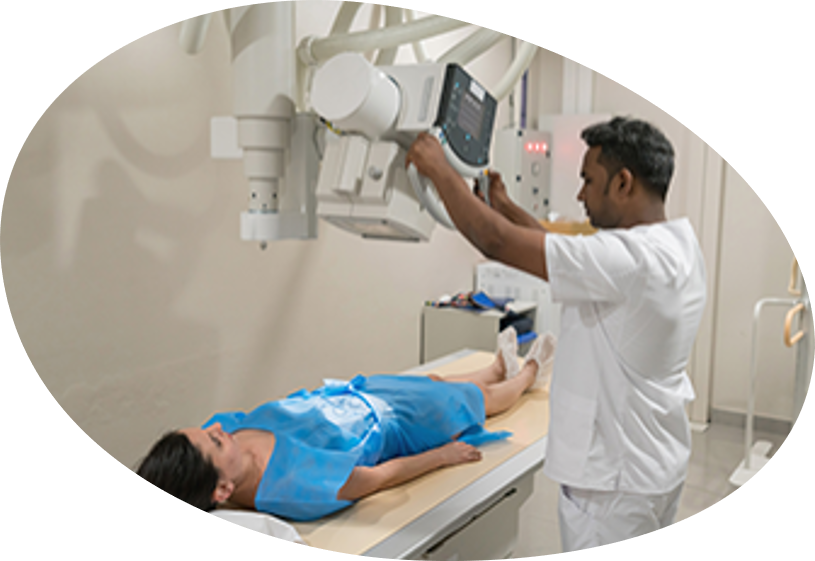Program Structure

Overview Of The Profession
Radiographers, or Radiologic Technologists, work under the direction of a radiologist or other qualified physician to perform medical imaging procedures on patients for diagnosis. Radiographers work in a variety of settings including but not limited to hospitals, walk-in clinics and physician offices. In hospital settings, radiographers perform medical imaging procedures in the medical imaging department, emergency department (ER), surgery, and bedside in patient rooms and critical care units.
During the performance of radiographic procedures, radiographers must communicate with and provide care to patients of all ages and in all physical conditions. Radiographers manipulate radiographic and patient care equipment to accurately demonstrate anatomical structures on medical images and to provide quality care. Radiographers work frequently with computer systems to enter patient information and produce digital radiographic images. Radiographers also prepare and administer contrast media and other medications within the scope of practice and applicable state and federal regulations. Radiographers exercise safety practices to minimize radiation exposure to patients, self and others.
Radiographers must be able to take direction from physicians and management and yet operate independently within the scope of practice and state and federal regulations. Radiographers use critical thinking in adapting radiographic examinations to unique circumstances and in assessing medical images for appropriate image quality and corrective actions, if needed. Radiographers must be emotionally stable to perform radiographic examinations on patients under difficult circumstances.
Radiographer salary varies throughout the country. As of July 2024, the average full-time salary in Indiana is $65,200 annually (https://www.salary.com/research/salary/alternate/radiographer-ii-salary/in ) but salaries can be more for specialty areas in medical imaging.

Essential Skills & Abilities
To practice radiography, radiographers must possess the following skills and abilities:
1. Physical/Motor Skills
- Stand and walk for extended periods of the time
- Perform physically strenuous tasks including raising patients in bed, maneuvering patients to and from tables/stretchers and carrying or maneuvering equipment
- Rise from a seated position without assistance
- Twist and bend at the waist
- Extend the hands and arms in any direction
- Hold, grasp and turn objects with the hands
- Reach up to six feet off the floor
2. Sensory Abilities
- Correctable near vision to 20 / 40 in at least one eye
- Correctable far vision to 20 / 40 in at least one eye
- Depth perception
- Distinguish shades of gray
- Hear audible speech (e.g. person-to-person communication) at 10 feet
- Hear speech when lips are not visible (e.g. wearing a surgical mask)
- Hear auditory alarms (e.g. patient monitors, fire alarms)
- Hear speech over a telephone
- Detect odors such as smoke, alcohol, noxious gasses
3. Communication Abilities
- Read documents in English
- Write legibly in English
- Speak fluently in English
- Understand speech in English
- Adapt verbal communication to patient/visitor limitations (e.g. hearing loss, pediatrics, diminished mental capacity)
4. Emotional and Behavior Skills
- Willingness to take directions
- Be self-directed and assertive
- Provide emotional support to others in distress
- Adapt to a changing environment
- Monitor own emotional state
- Manage frustration appropriately
- Accept responsibility for own errors or shortcomings
- Express emotions in a socially-acceptable manner
- Respect interpersonal boundaries
- Manage interpersonal and organizational conflicts in a respectful and professional manner
5. Intellectual Abilities
- Recall information with reasonable accuracy
- Recognize cause and effect relationships
- Anticipate/plan ahead for activities or situations
- Perform tasks in a logical and efficient sequence
- Prioritize competing tasks
- Problem solve when the solution is not self-evident
- Use visual/spatial processing in evaluating radiographic images
- Demonstrate attention to detail
- Evaluate own performance to determine corrective actions when appropriate
Assessment Of Essential Skills & Functions
Ascension St. Vincent Radiography Program does not discriminate on the basis of disability as determined by the American with Disabilities Act (ADA). Physical/motor skills, sensory abilities, and communication skills are not assessed during the selection phase of the admissions process.
Emotional/behavioral skills and intellectual abilities are assessed during the selection phase of the admissions process as they relate to a candidate’s academic record, and ability to communicate effectively in English during a personal interview.
